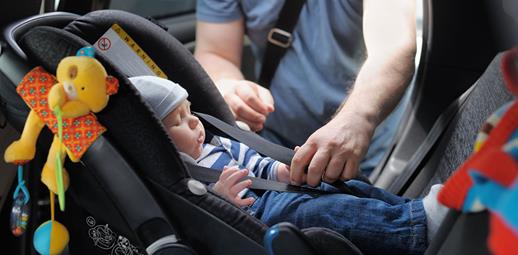
The rules on car seats for babies and children, and when you need to upgrade them, can be a little confusing.
There have been several rule changes in recent years and some seats fit children based on their height, while others depend on their weight.
You’re not alone if you’re unsure when your child needs a car seat upgrade. Nearly two thirds (59%) of children are sitting in car seats that are inappropriate for them or haven’t been fitted properly, according to 2018 research from car seat experts Child Seat Safety.
But it’s essential to get it right, as otherwise it can be both dangerous and uncomfortable for your child.
Here’s a summary of what type of car seat you need and when.
From hospital pick-up to at least 15 months
If you can, start with an i-Size seat, a new type of height-based seat, designed to be safer and easier to fit.
These seats are intended to keep children rear-facing for longer, until they’re at least 15 months old.
But if you can keep your child rear-facing for longer than that, then do so, as it will mean their head, neck and spine are better protected. Parents often move their baby to a forward-facing seat too soon, according to childcarseats.org.uk.
The height limit varies from seat to seat, so check the label on your seat. According to consumer group Which? some i-Size seats can be used rearward-facing until your child reaches 105cm, which is around four years of age.
This type of seat fits in most cars that have ‘IsoFix’ fittings, which have been standard in the majority of cars since 2007. But even so, not all will be compatible with i-Size seats. You'll need to check the list of approved vehicles that fit the seat and check the fitting in your car.
If you can’t fit an i-Size seat in your car, then you’ll need a weight-based seat that keep the child rearward-facing until they are 18 kg in weight, which is roughly four years old.
If you already have a seat
While in the future (a date has not yet been set) only height-based i-Size seats will be allowed in the UK, for now most child car seats are still grouped according to the weight of the child.
So, if you already have a seat, you don’t need to swap it for an i-size one, unless you want to.
Once your child has outgrown their rear-facing seat
Forward-facing i-Size seats are being developed but aren’t yet available. So, you’ll need a weight-based forward-facing child seat.
Here is a list of the different weight-based groupings – you’ll see that Group 1 and above includes forward-facing seats.
Group 0 seats are for babies up to 10kg: a lie-flat or ‘lateral’ baby carrier, rear-facing baby carrier, or rear-facing baby seat using a harness.
Group 0+ seats are for babies who weigh up to 13kg: a rear-facing baby carrier or rear-facing baby seat using a harness.
Group 1 seats are for infants who weigh 9-18kg: a rear or forward-facing baby seat using a harness or safety shield.
Group 2/3 seats are for children who weigh 15-36kg: a rear or forward-facing child car seat (high-backed booster seat or booster cushion) using a seat belt, harness or safety shield.
12 years old or 135 centimetres tall
Children must use a child car seat until they’re 12 years old or 135 centimetres tall, whichever comes first. After that, a car seat is no longer required, but they must wear a seat belt.
Manage your account online
It's easy to manage your insurance online - make a change, review your cover, renewal options and more.
